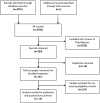Risk factors for severe neonatal hyperbilirubinemia in low and middle-income countries: a systematic review and meta-analysis
- PMID: 25675342
- PMCID: PMC4326461
- DOI: 10.1371/journal.pone.0117229
Risk factors for severe neonatal hyperbilirubinemia in low and middle-income countries: a systematic review and meta-analysis
Abstract
Background: Available evidence suggests that low- and middle-income countries (LMICs) bear the greatest burden of severe neonatal hyperbilirubinemia characterized by disproportionately high rates of morbidity, mortality and neurodevelopmental disorders compared to high-income countries. We set out to identify the risk factors that contribute to the burden of severe hyperbilirubinemia in the most developmentally disadvantaged LMICs to highlight areas for action and further research.
Methods: We systematically searched PubMed, Scopus, Ovid EMBASE, Cumulative Index to Nursing and Allied Health Literature (CINAHL), WHO Library Database (WHOLIS), African Index Medicus (AIM), African Journals Online (AJOL), LILACS, and IndMed for reports published between January 1990 and June 2014. We included only studies that controlled for the effects of confounding variables in determining maternal and infant risk factors for severe hyperbilirubinemia. We conducted meta-analysis of the eligible studies and computed the summary risk estimates with random effects models.
Results: A total of 13 studies with 1,951 subjects and 32,208 controls from India, Nigeria, Pakistan, Nepal and Egypt were identified and analyzed. The pooled data showed that primiparity (OR, 1.59; 95% CI:1.26-2.00), delivery outside public hospitals (OR, 6.42; 95% CI:1.76-23.36), ABO incompatibility (OR, 4.01; 95% CI:2.44-6.61), Rhesus hemolytic disease (OR, 20.63; 95% CI:3.95-107.65), G6PD deficiency (OR, 8.01; 95% CI:2.09-30.69), UGT1A1 polymorphisms (OR, 4.92; 95% CI:1.30-18.62), low gestational age (OR, 1.71; 95% CI:1.40-2.11), underweight/weight loss (OR, 6.26; 95% CI:1.23-31.86), sepsis (OR, 9.15; 95% CI:2.78-30.10) and high transcutaneous/total serum bilirubin levels (OR, 1.46; 95% CI:1.10-1.92) placed infants at increased risk of severe hyperbilirubinemia or bilirubin induced neurologic dysfunctions. Low social class was not associated with an increased risk of severe hyperbilirubinemia.
Conclusions: Infants at risk of severe hyperbilirubinemia in LMICs are associated with maternal and neonatal factors that can be effectively addressed by available interventions to curtail the disease burden prevailing in the affected countries.
Conflict of interest statement
Figures
References
Publication types
MeSH terms
LinkOut - more resources
Full Text Sources
Other Literature Sources
Miscellaneous



